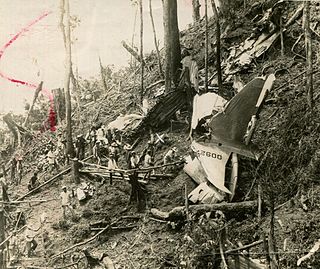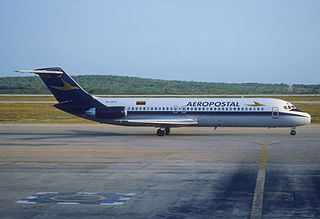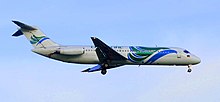Cebu Air, Inc., operating as Cebu Pacific, is a Philippine low-cost airline based at Pasay in Metro Manila. Founded in 1988, it is Asia's first low-cost airline. It offers scheduled flights to both domestic and international destinations. The airline operates flights from five bases in Cebu, Clark, Davao, Iloilo, and its largest base in Manila.

China Airlines Flight 642 was a flight that crashed at Hong Kong International Airport on 22 August 1999. It was operating from Bangkok to Taipei with a stopover in Hong Kong.

The Douglas C-54 Skymaster is a four-engined transport aircraft used by the United States Army Air Forces in World War II and the Korean War. Like the Douglas C-47 Skytrain derived from the DC-3, the C-54 Skymaster was derived from a civilian airliner, the Douglas DC-4. Besides transport of cargo, the C-54 also carried presidents, prime ministers, and military staff. Dozens of variants of the C-54 were employed in a wide variety of non-combat roles such as air-sea rescue, scientific and military research, and missile tracking and recovery. During the Berlin Airlift it hauled coal and food supplies to West Berlin. After the Korean War it continued to be used for military and civilian uses by more than 30 countries. It was one of the first aircraft to carry the President of the United States, the first being President Franklin D. Roosevelt during World War II.
This is a list of aviation-related events from 1976.
This is a list of aviation-related events from 1978.

China Northern Airlines Flight 6136 (CBF6136/CJ6136) was a Chinese domestic passenger flight from Beijing Capital International Airport to Dalian Zhoushuizi International Airport. On 7 May 2002, the McDonnell Douglas MD-82 operating the flight crashed into the bay near Dalian shortly after the pilot reported "fire on board", killing all 103 passengers and 9 crew members. The cause of the fire was later determined to be arson.

The McDonnell Douglas DC-9 is an American five-abreast, single-aisle aircraft designed by the Douglas Aircraft Company. It was initially produced as the Douglas DC-9 prior to August 1967, after which point the company had merged with McDonnell Aircraft to become McDonnell Douglas. Following the introduction of its first jetliner, the high-capacity DC-8, in 1959, Douglas was interested in producing an aircraft suited to smaller routes. As early as 1958, design studies were conducted; approval for the DC-9, a smaller all-new jetliner, came on April 8, 1963. The DC-9-10 first flew on February 25, 1965, and gained its type certificate on November 23, to enter service with Delta Air Lines on December 8.
Lumbia Airfield, formerly known as Lumbia Airport and Cagayan de Oro Airport, is an air base and was the main civilian airport that served the general areas of Cagayan de Oro and Northern Mindanao, in the province of Misamis Oriental in the Philippines. It was the second busiest airport in Mindanao, after Francisco Bangoy International Airport in Davao City before the opening of Laguindingan Airport.

Daniel Z. Romualdez Airport, also known as Tacloban City Airport, is an airport serving the general area of Tacloban, a highly urbanized city in the Leyte island of the Philippines. It is the main gateway from Manila and Cebu to Eastern Visayas. It is classified as a Class 1 principal airport by the Civil Aviation Authority of the Philippines. In 2022, Daniel Z. Romualdez Airport served 1.48 million passengers, making it the seventh-busiest in the country.

Inex-Adria Aviopromet Flight 1308 was a McDonnell Douglas MD-81 aircraft operating a Yugoslavian charter flight to the French island of Corsica. On 1 December 1981, the flight crashed on Corsica's Mont San-Pietro, killing all 180 people on board. The crash was the deadliest and first major aviation accident involving a McDonnell Douglas MD-80.

On March 17, 1957, a C-47 Skytrain transport aircraft crashed on the slopes of Mount Manunggal on the island of Cebu in the Philippines. The crash killed 25 of the aircraft's 26 occupants, including the incumbent president of the Philippines, Ramon Magsaysay. Several high-ranking Philippine government officials, military officials, and journalists were also among the dead. The sole survivor was a reporter for the Philippine Herald, Nestor Mata.

Philippine Airlines Flight 206 (PR206) was the route designator of a domestic flight from Manila Domestic Airport, Metro Manila, Philippines, to Loakan Airport, Baguio. On June 26, 1987, the Hawker Siddeley HS 748 crashed onto a mountain en route to Baguio, killing all 50 people on board.

Viasa Flight 742 was an international, scheduled passenger flight from Caracas, Venezuela to Miami International Airport with an intermediate stopover in Maracaibo, Venezuela that crashed on 16 March 1969. After taking off on the Maracaibo to Miami leg, the McDonnell Douglas DC-9-32 hit a series of power lines before crashing into the La Trinidad section of Maracaibo. All 84 people on board perished, as well as 71 on the ground.

Aeropostal Alas de Venezuela Flight 108 was a short-haul flight from La Chinita International Airport in Maracaibo, Venezuela to Santa Barbara Ed-L Delicias Airport that crashed on March 5, 1991.

Philippine Airlines Flight 443 was an early morning domestic flight that crashed on approach to Maria Cristina Airport, on December 13, 1987. The flight was intended to fly to Malabang Airport after arriving in Iligan before returning to Cebu.

On August 18, 2012, a Piper PA-34 Seneca light aircraft with four people on board, including Philippine Interior Secretary Jesse Robredo, crashed in the sea near the island province of Masbate, Philippines, while flying from Lapu-Lapu City to Naga, Camarines Sur. Robredo and two other occupants were killed in the accident.













